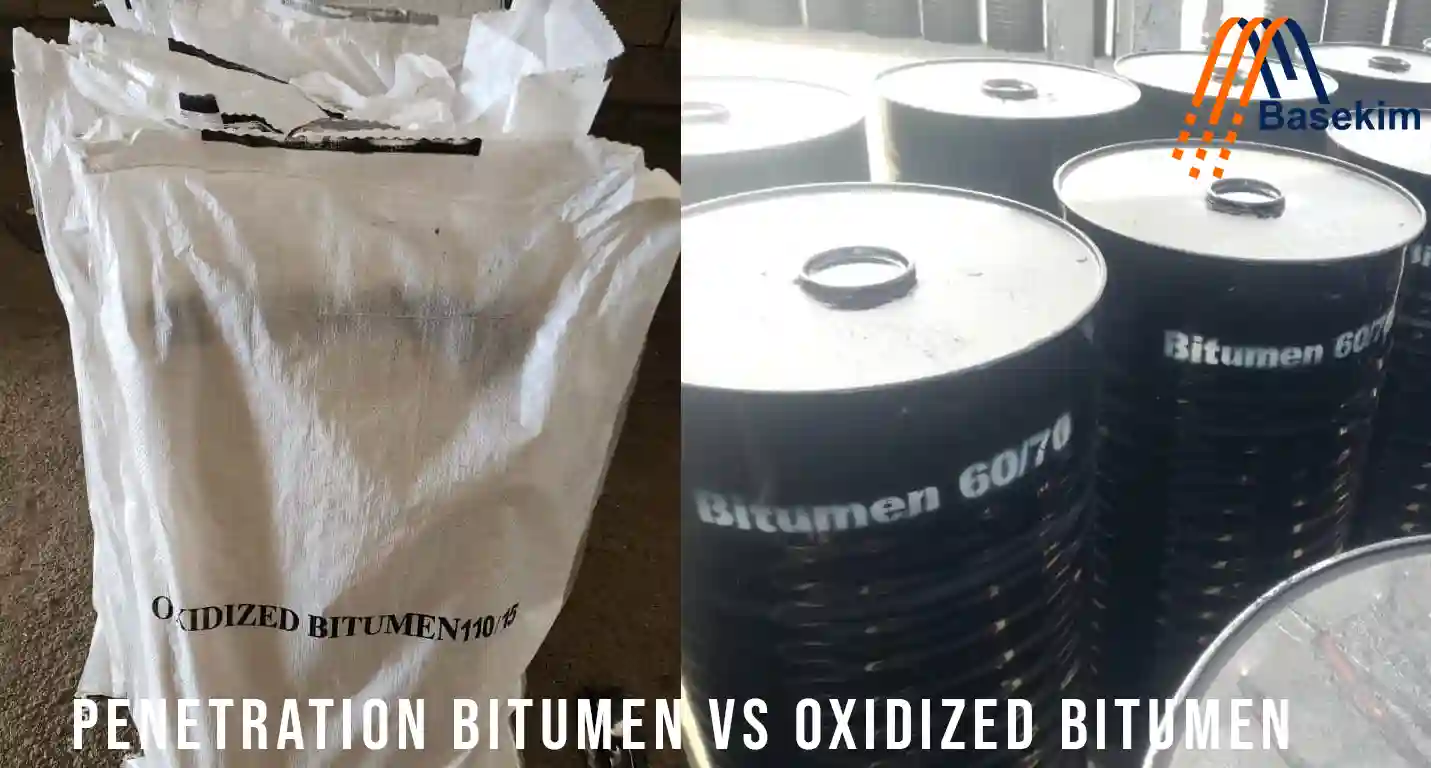
When engineers and buyers compare penetration bitumen vs oxidized bitumen, they want clear information before choosing the right product. At Basekim, we supply both grades in high quality, and we help clients understand which type works best for their project. Because roads, roofs, and industries need reliable materials, choosing the correct bitumen makes work easier, safer, and more cost-effective. In this guide, you will learn the real differences in a simple and friendly way so you can decide with confidence.
What Is Penetration Bitumen?
Penetration bitumen is a common grade used mostly in road construction. It gets its name from a simple test. In this test, a needle pushes into the bitumen, and the depth shows the hardness. A higher number means a softer grade. A lower number means a harder grade.
Examples:
Bitumen 60/70 – medium hardness
Bitumen 80/100 – softer
Bitumen 40/50 – hard
This type of bitumen comes from the vacuum bottom of crude oil without any air-blowing process. It keeps a natural balance between hardness and flexibility. That is why engineers choose it for hot mix asphalt, highways, and other surfaces that experience heavy traffic.
Penetration bitumen works well in hot climates, cold climates, and normal roads. It also mixes easily with aggregates. As a result, contractors use it in almost every country.
What Is Oxidized Bitumen?
Oxidized bitumen, also called blown bitumen, is made by blowing hot air into penetration bitumen. This process changes its structure and makes it harder, stronger, and more heat-resistant. Because of this transformation, oxidized bitumen performs well in industrial applications where extra stability is important.
Common grades include:
Bitumen 85/25
Bitumen 90/40
The two numbers show softening point and penetration level. For example, 115/15 means a softening point of 115°C and a penetration of 15 dmm.
Oxidized bitumen does not melt easily under the sun. It keeps its shape, stays firm, and provides strong waterproofing. That is why people use it for insulation, roofing, flooring, pipe coating, paints, and industrial sealing.
Penetration Bitumen vs Oxidized Bitumen: Main Differences
Understanding penetration bitumen vs oxidized bitumen becomes easy when you compare them side by side. Even though both come from crude oil, they behave very differently.
1. Production Method
Penetration bitumen: Made naturally from crude oil distillation without extra processing.
Oxidized bitumen: Produced by blowing hot air into bitumen to increase hardness and heat resistance.
Because the production methods differ, the performance also changes.
2. Hardness and Flexibility
Penetration bitumen: More flexible. Works well in asphalt roads because it bends under wheel pressure.
Oxidized bitumen: Much harder. Perfect for industrial uses where a strong, firm material is needed.
Flexibility helps asphalt survive daily movement, while hardness helps seal surfaces and prevent deformation.
3. Temperature Performance
Temperature is one of the biggest differences in penetration bitumen vs oxidized bitumen.
Penetration bitumen: Performs well in both warm and moderate climates. But extreme heat can soften it.
Oxidized bitumen: Handles very high temperatures without melting. It remains stable even under strong sunlight.
This is why oxidized bitumen is common in hot countries for roofing and waterproofing.
4. Common Uses
Because their properties are different, their uses also change.
Penetration Bitumen Uses
Road construction
Asphalt concrete
Airport runways
Pavement layers
Driveways
Surface dressing
Oxidized Bitumen Uses
Waterproofing
Roofing felt
Crack sealing
Pipe coating
Expansion joints
Flooring mastics
Electrical materials
Roads need flexibility. Buildings and factories need strength. That is why each type has its own place.
5. Softening Point
Penetration bitumen: Usually around 45–55°C
Oxidized bitumen: Can reach 85–115°C or even higher
A higher softening point means stronger heat resistance, which is why industries choose oxidized grades.
6. Behavior Under Pressure
Penetration bitumen: Moves slightly under pressure, which protects roads from cracking.
Oxidized bitumen: Stays firm and does not deform. This makes it ideal for sealing, coating, and insulation.
Which One Should You Choose?
Choosing between penetration bitumen vs oxidized bitumen depends on your project:
Choose Penetration Bitumen If:
You build a road or highway
You need flexible asphalt
You want good performance in traffic
You mix the bitumen with aggregates
Choose Oxidized Bitumen If:
You work on roofing or waterproofing
You need strong resistance to heat
You require hard material for sealing
You want long-term industrial protection
Both types serve different purposes. Using the wrong one can cause damage, shorter lifespan, or higher maintenance costs.
Why Many Buyers Trust Basekim
Because buyers want strong quality control and fast delivery, many of them choose Basekim when they need either penetration or oxidized bitumen. We supply stable grades, clear documents, accurate specs, and packaging that protects the product during shipping. We also guide clients to pick the best grade based on climate, usage, and project requirements. With us, the process becomes easy and safe.
FAQs
1. Is penetration bitumen cheaper than oxidized bitumen?
Yes, penetration bitumen is usually cheaper because it requires less processing. Oxidized bitumen takes more time and energy to produce, so the price is higher.
2. Can I use oxidized bitumen for road construction?
Not recommended. Oxidized bitumen is too hard for roads. It can cause cracks and poor performance. Roads need penetration bitumen because it stays flexible.
3. Which type lasts longer?
It depends on the application. Penetration bitumen lasts longer in roads. Oxidized bitumen lasts longer in roofing, waterproofing, and industrial uses. Each one is the best in its own category.
conclusion
In conclusion, understanding penetration bitumen vs oxidized bitumen helps you choose the right material for your project. Both have clear advantages, and each one performs best in different conditions. Whether you need high flexibility or strong heat resistance, Basekim is ready to supply reliable grades with professional support and fast delivery.
